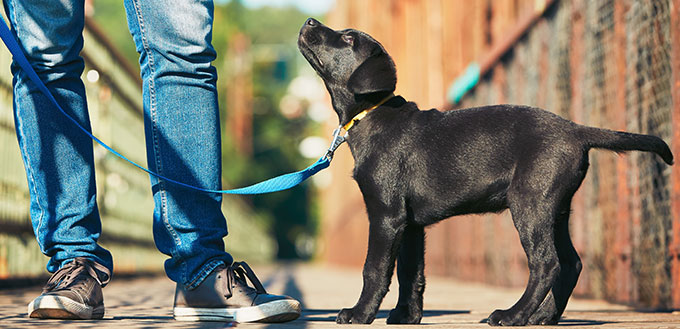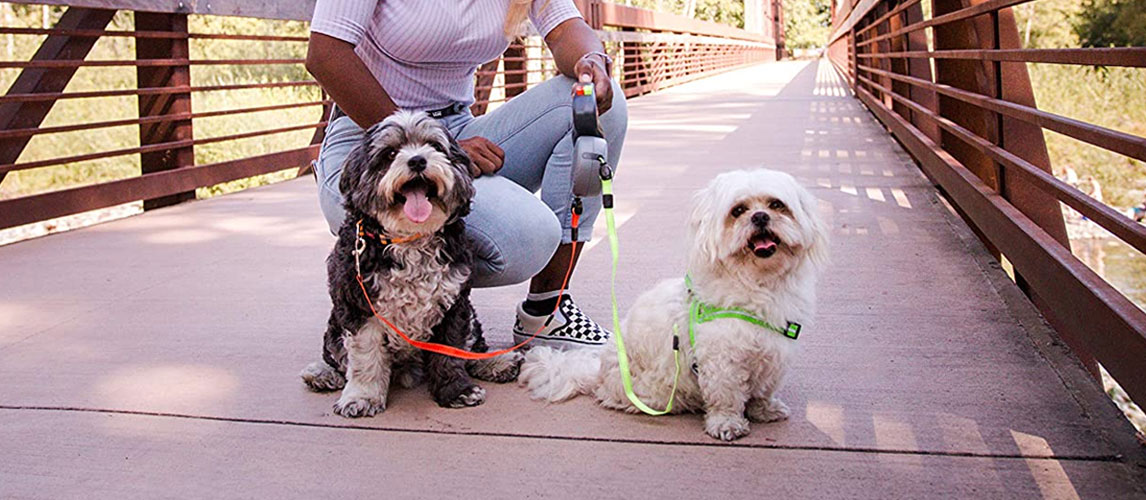Your furry friend needs a little more exercise than you do during the day. But just how long and how far must you walk your dog each day? Don’t fret, we’re here to tell you! For most dogs, a walk isn’t just about getting their little heart pumping faster or getting in a quick workout. Dogs need to go on daily walks to do their business, to socialize, and to maintain positive mental health. The distance depends entirely on you and your dog!
Dog Walking Tips and Tricks
Walking your dog can be as simple one, two, three. However, new dog owners can accidentally make mistakes when choosing walking gear or when taking their dogs out. This is because there’s a lot of misinformation out there. Pet shops can sometimes sell gear that is actually harmful for your dog to wear.
Don’t worry, though, we’ve complied enough tips and tricks for you to use that even the newest dog owner will have a good grasp on dog walking and its intricacies.
How Far Should I Walk My Dog – Puppy Edition
How about puppy miles? Full-grown and healthy dogs can walk up to 10 miles, especially if they enjoy being outdoors. Standard hunting breeds are a good example of an outdoor loving pooch. Puppies, on the other hand, shouldn’t really be walking anywhere near that length until they’re much older.
How Long to Walk a Dog or Puppy
Your adult dog is likely to be happy with a walk that lasts from one to three miles. However, that shouldn’t stop you from taking your puppy on that same walk! You just need to be aware of their puppy mile limit.
Puppy Miles
Puppies can cover one to two miles without any issue. They might be a bit worn out after a longer journey, but they should be able to keep up with the rest of your dog pack as long as you hold a steady pace.
Even if you believe your little one can handle a couple puppy miles, be aware that over-walking your younger dogs can lead to medical and growth issues if you do it too often. This is especially important if you have a puppy that is bound to be a large dog. Larger dog breeds are prone to joint problems, especially if they’re pushed too hard when they’re still puppies.
Take your puppy miles a little bit at a time and take note of when your puppy gets tired. Stay close to home until you can figure out their limits. Listen to any advice your vet may have for you, too.
Should I Walk My Dog in the Rain?
Provided that it’s not storming out and it’s safe to do so, there’s no reason that you can’t walk your dog in the rain! We wouldn’t advise walking a puppy in the rain, as they have a harder time regulating their temperature and could be more prone to illness.
An adult dog, however, is much sturdier. Many breeds actually enjoy splashing around in the mud and playing in puddles. Believe it or not. There are environmental factors to take into consideration, though. As long as you take precautions, there’s no real reason you shouldn’t walk your healthy, adult dog in the rain for a bit. It will certainly be entertaining! You could even practice a musical number with your umbrella.
How Long Should I Walk My Dog in the Rain?
Protecting your pup should be the first thing you consider before taking them out on a rainy walk. Dog boots can offer protection from anything harmful that could get washed up through the streets. A canine winter coat or a dog raincoat is also a must to keep your pup’s temperature from dropping too harshly. These are just a couple examples of the many wet weather solutions available to you and your dog.
Consider your dog’s feelings on the matter. If they need to do their business, could you use a litter tray or send them into the yard instead? If they haven’t had any exercise that day, then set up something inside for them to use. Although there’s no issue with walking a dog in the rain, there are a lot of unknown factors. For example, your dog may not actually like the rain. Rain is refreshing, but sometimes, it’s messy and annoying. If your dog doesn’t like baths or getting wet, they probably aren’t going to thank you for an unwarranted, and very wet, walk.
How Far Should I Walk My Dog on Hot Days?
As an alternative, you can also walk your dog on hot days. Though just like with rainy days, there are many factors to consider before taking your dog out into the blazing heat. Instead of rain obscuring your view of the ground, you suddenly have scorching hot pavement. Ouch!
If the ground is too hot for your bare skin, then it’s certainly too hot for your pup. Taking your dog on a walk where their paws will burnt is, frankly, mean and irresponsible. If it’s that hot, then just keep your dog inside.
You can, however, take your pup on a hot day walk provided you have the right equipment. At the very least, you should bring a bowl and a bottle of clean, fresh water with you. These items are so easy to carry, there’s really no excuse for not having them.
There are also dog vests that can be soaked in water before being put on your pup. They dry out over time and can have a wonderful cooling effect on your furry friend.
How Long Should I Walk a Dog Pack?
If you’re an owner of several dogs and are preparing for your first pack walk, then don’t worry, we’ve got some advice for you, too. You might want to keep the first couple walks short until you find your feet.
Tangled leashes are an absolute nightmare for multi-dog households. Before you even attempt a pack walk, make sure you have a decent leash. This means one that is made for walking multiple dogs at the same time. Choose a dog leash that has one handle with two double-clipped leads. You’re less likely to find dogs running circles around you, then!
You’ll also want to choose one of the dogs to “lead the pack”. This should be the most well-trained dog, and hopefully one of the bigger ones you’re walking. The rest of the pack should naturally follow their leader, which will take some of the strain off you.
Don’t walk more dogs than you can handle. You might have four dogs at home, but can you control them all at once? If you can’t, then it’s time to invest in some leash training and perhaps hire an expert dog walker to better work with your pups.
Training Your Dog to Walk Off-Leash
Off-leash training should start the moment you begin teaching your dog commands. Doing both of these in tandem is great for puppies because you have complete control over their development from a young age. It’s a little harder with older dogs, but definitely not impossible!
There is, of course, leash obedience training. This kind of training can be done at home or by a professional dog trainer. Your dog will learn to always keep their eyes and their focus on you, no matter what distractions are around them.
Training starts by using a leash to keep control of your pup during the walking process. Once you’ve mastered this, you can gradually lengthen the leash and train your pup to come to you when they’re called.
Treats are great for this kind of training. Always use positive reinforcement, never punishment! Dogs don’t respond well to punishment; it just confuses them and makes them feel negative emotions, which they will associate with you.
After your dog is responding to you and coming when called, you can take the leash away. It’s a long process, but one that is certainly rewarding!
Harnesses
If your dog has a tendency to pull while you’re walking them, consider the type of leash you’re using. A dog harness with a back clip can sometimes promote pulling, as your dog is likely to ignore you while you’re trying to control them.
When your dog isn’t looking at you, it’s much easier for them to keep their attention on whatever object, person, or other dog holds their attention most.
Instead of a back clip harness, use a front clip, so that your dog will always have their attention on you when you’re out walking. This kind of harness won’t solve all your problems. Add some dedicated training, alongside a change of harness, and it will certainly help the situation.
A front leash attachment ensures your pup stays at your heels during the entire walk. There’s no way for them to pull ahead of you, as they’ll end up getting caught in the leash if they try.
A great example of a front clip harness is the Deluxe Easy Walk Harness from PetSafe. It’s fully adjustable, with four different adjustment points to ensure the best fit for your dog. The chest straps ensure your pup won’t hurt themselves, too, unlike other harnesses that wrap around a dog’s throat.
Read here our detailed PetSafe Deluxe Easy Walk Harness Review.
Dos and Don’ts
Here are some answers to the thousands of questions still plaquing your mind. The general “dos and don’ts” while walking your dog are as follows:
Do:
- Let your dog sniff their surroundings. This is completely normal and an important part of their instincts. For a dog, finding new smells is like finding buried treasure!
- Let your dog greet other dogs (that means sniffing them). Dogs identify each other by their scent.
- Take your dog out walking at least twice a day. Even a short walk can be hugely beneficial to your pup.
- Focus on your dog as much as possible. If you’re looking away, they might stray, too.
- Think ahead. It’s important to plan for the time you’re spending outdoors with your pup. Plan your route and be consistent.
- Reward your dog immediately.
- Also, admonish your dog immediately. Admonish, not punish. If your dog does something bad, follow your discipline routine at that exact moment. Don’t wait until after your walk! If you wait, chances are they won’t remember what they did wrong.
Don’t:
- Let your dog sniff nervous or aggressive dogs. In the event that you’re coming up to someone who is walking an obviously nervous or aggressive dog, then make sure to keep your distance.
- Miss a day of walking your dog. If you don’t have the time, then ask a family member, a friend, or hire a dog walker for the day. Your dog needs a minimum of 30 minutes to two hours of exercise every day. That doesn’t need to be solely walking, either! You should be taking your dog out to socialize and take care of their doggy business.
- Spend the whole walk on your phone. Interact with your pup, take them to the park, or play a game with them. You can even get some leash training in while you’re out walking together.
FAQs:
Q: Is a 20-minute walk enough for a dog?
A: You should try to walk your dog for a minimum of 20 minutes at a time. If you took your dog out for 20 minutes three times a day, they’d get in a decent hour of exercise and socialization.
We can only hope that you’re taking them out at least once a day, but in reality, you should be walking your dog twice a day, 30 minutes to an hour each time. Distance doesn’t matter as much if you’re walking a healthy and active, adult dog. Puppy miles is a different beast entirely!
Q: Can I over-walk my dog?
A: This question entirely depends on your dog’s history. If your pup isn’t used to a lot of exercise, suddenly expecting them to handle an hour of walking every day could push them over the limit. That can result in injury or medical issues.
A fit and healthy dog with no prior medical issues or past injuries should be able to handle several hours of exercise and play each day. When in doubt, think about how you would feel if someone was forcing you to walk as much as you were asking your dog to. You can also call your vet! Make sure to follow any extra advice they may have, too.
Q: Should I let my dog sniff on walks?
A: If it’s safe to do so, you certainly should! Dogs rely on their noses to find new and familiar scents. Smells are like a map to a dog. It helps them enjoy the walk more and explore new territory!
Q: Is it better to walk my dog in the morning or at night?
A: We recommend two to three walks each day for your dog. So, one in the morning and one at night! These don’t need to be hours long, of course, or you’d spend all day walking your dog. If you space out your walks near the time you would feed them, then they can also go to the bathroom during their walks.
With that in mind, it’s easiest to walk your dog once during the morning, and once during the evening. Some dog owners really enjoy going on an hour-long excursion with their dog when there are fewer people around. The best times for this are early morning or later at night.
Be careful not to go too late, otherwise you may want to bring someone else with you. That way, you aren’t walking your dog completely alone in the middle of the night. Happy hiking!
Sources:
- Krista Williams, BSc, DVM, The Benefits of Walking Your Dog, VCA
- Tips For Making a Walk With Your Dog a Walk In The Park, Animal Humane Society
- 10 Truths About Dog Walking, Michelson Found Animals
Note: The advice provided in this post is intended for informational purposes and does not constitute medical advice regarding pets. For an accurate diagnosis of your pet's condition, please make an appointment with your vet.











